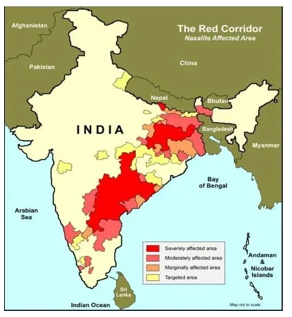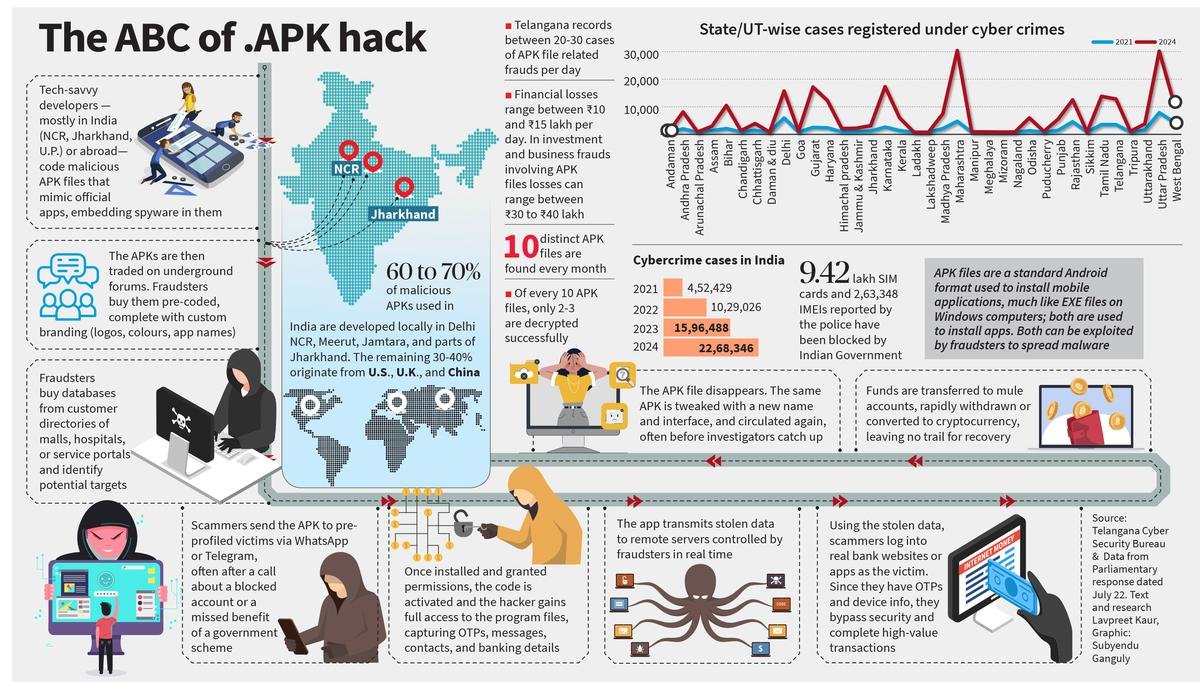Relevance: GS III; Internal Security;
Why in the News?
Recently, the Prime Minister publicly reiterated the Indian government’s policy of “zero tolerance” against terrorism and Naxalism (Left-Wing Extremism).
- He made this statement while inaugurating the Northeast Rising Summit on May 23, 2025.
What is Left-Wing Extremism (LWE) in India?

- LWE, commonly known as Naxalism or Maoism, refers to armed insurgency movements in India that seek to overthrow the existing democratic state structure through violent means, inspired by radical leftist and Maoist ideologies.
- This movement originated from the 1967 uprising in Naxalbari (West Bengal), led by members of the Communist Party of India (Marxist)
- The CPI- the main LWE outfit in India, is known for its adherence to Maoist ideology and its objective of establishing a “New Democratic Revolution” through armed struggle.
- This quickly spread to underdeveloped, tribal-dominated, and rural regions in central and eastern India, often called the “Red Corridor”. (as shown in the map)
- This movement is characterized by a focus on social justice, land rights, and the rights of marginalized communities.
Status of Left Wing Extremism in India:
- According to the data declared by the Central government in 2022, overall violent occurrences in Naxal-affected regions reduced by 76% as compared to 2010.
- As per the Multidimensional Poverty Index (MPI) by the Oxford Poverty and Human Development Initiative, regions affected by left-wing extremism, like Jharkhand, are driven by high levels of deprivation, contributing to discontent.
- Poor Governance: Lack of effective governance and corruption often exacerbate feelings of alienation and injustice, driving people towards extremism.
- Illiteracy and Unemployment: These factors, evident in Odisha, contribute to the vulnerability of individuals to extremist ideologies.
What are the challenges that India faces due to the rise in Left Wing Extremism?
- Internal Security Threat: LWE poses a direct threat to India’s internal security by targeting security forces, police, government officials, and critical infrastructure. This undermines the state authority, disrupts law and order, and creates “liberated zones” where state presence is minimal or absent.
- For example, the major operations in Chhattisgarh, such as the neutralization of 16 Naxalites in Sukma (March 2025) and 27 killed in Narayanpur (May 2025), highlight ongoing violent confrontations.
- Socio-Economic Underdevelopment: The government acknowledges that Naxalism has stalled progress in Central and Eastern India, preventing education, healthcare, and connectivity from reaching remote villages.
- For example, the number of LWE-affected districts has reduced, but the remaining areas still struggle with development bottlenecks.
- Exploitation and Alienation of Tribal and Marginalized Populations: The LWE movement usually exploits grievances of tribal and marginalized groups, such as landlessness, displacement due to mining or industrial projects, and denial of rights over land and forests.
- Inadequate rehabilitation and social exclusion fuels the resentment towards the government and support for extremist groups.
- In Chhattisgarh and Telangana, Maoists continue to recruit from tribal populations by leveraging local discontent and resistance to state-led projects.
- The surrender of 50 Naxalites in Bijapur (March 2025) reflects ongoing efforts to bring alienated groups back into the mainstream
- Governance and Administrative Deficit: Weak governance, corruption, and failure to deliver justice or basic entitlements erode public trust in state institutions. LWE groups often fill this vacuum by providing alternative systems of governance and justice.
- Despite security gains, forest areas like Chhattisgarh and Jharkhand still witness sporadic violence and attempts by Maoists to reassert control, like the security camps reclaimed along the Chhattisgarh-Telangana border (April–May 2025).
What are the government’s initiatives to counter LWE?
- Initiatives like ‘Aspirational Districts Programme’ aim to address socio-economic disparities and curb extremism.
- Enhanced Security Operations like ‘Operation Green Hunt’ focus on neutralizing extremists and reclaiming areas under their control.
- National Policy and Action Plan (2015): The central government approved this policy aiming to address LWE comprehensively. The policy adopts a multi-pronged strategy which includes:
- To strengthen the security operations against LWE groups.
- Addressing the root causes of extremism by promoting infrastructure.
- Ensuring that local people benefit from development projects..
- Collaborative Efforts: The state governments demonstrate a collaborative effort by having meetings and reviews with chief ministers and officials of affected states to promote cooperative federalism.
- SAMADHAN Strategy: The Ministry of Home Affairs developed the comprehensive strategy that covers multiple aspects like:
- It encourages the development of astute leaders capable of making informed decisions.
- It involves adopting an assertive approach, including proactive security operations and robust policy measures.
- It aims to boost the morale and skills of security forces and other stakeholders.
- It enhances intelligence capabilities to preemptively detect and neutralize threats.
- It optimizes efficiency by using modern technology for intelligence, surveillance, and operational efficiency.
Need for an integrated and multi pronged strategy: (Way Forward)
- Security Measures: Continue strengthening the capacity of state police and Central Armed Police Forces (CAPFs), modernize equipment, and improve intelligence sharing. Establish more Counter Insurgency and Anti-Terrorism (CIAT) schools and fortified police stations in affected areas.
- Development Initiatives: Accelerate infrastructure projects (roads, telecom, electricity), improve healthcare and education, and ensure that government schemes reach the grassroots. Special focus on expanding road networks and digital connectivity can reduce isolation and improve state presence.
- Community Rights and Entitlements: Ensure land rights, forest rights, and access to traditional resources for tribal and marginalized populations. Fast-track the implementation of the Forest Rights Act and other welfare schemes to build trust and address core grievances.
PYQ Relevance:
|




